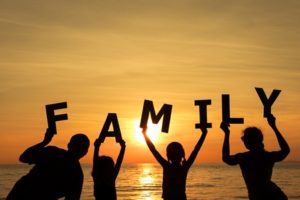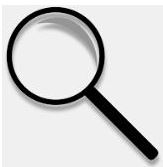
Last blog I mentioned Joseph Reid, the father-in-law of my husband’s 5th cousin twice removed. You may be wondering why in the world I would have someone in my tree that is not related and so far removed. Here’s the deal…I have done several surname studies which includes everyone by the same surname in a particular area. My purpose was twofold; I wanted to try to connect all the Harbaughs in the U.S. and updated the last attempt to do so, the 1947 Cooprider & Cooprider Harbaugh History book.
As was common until the 20th century, the Harbaugh couples had many children so my tree became quite large. (I’ve also did a surname study of the Leiningers but they immigrated later and didn’t have quite as many children in each generation but that, too, added non relatives to my tree.)
Since I have so many Harbaughs in one place and I documented each one as best as possible when I added them, I am frequently emailed about our connections. Usually, the question is, “How are you related to my (fill in the blank) Harbaugh?” Actually, I’m not, my husband would be the relation. I guess folks don’t see the Ancestry.com relationship info at the top of the page:

I try to always respond and let the the person who is inquiring know that all the information I have is public and posted.
When doing the surname study, if information was available, I would include the parents of the person who married into the Harbaugh family but I didn’t research that distant individual. That’s why Joseph Reid, the father-in-law, was in my tree. Joseph Reid’s son was Joseph Shortridge Reid (26 Aug 1889 MO-5 Jan 1938 MO) who married Ruth Arelia Harbaugh (11 Feb 1891 MO – 29 Jun 1969 MO). The couple had 2 daughters and a son. The email I received regarding the Harbaugh-Reids was inquiring if I had a photo of Joseph Shortridge Reid Jr. who died on 17 Apr 1945 as a casualty in WW2.
The Fields of Honor Database is an organization devoted to memorializing the 28,000 American service personnel that were killed or missing in the line of duty. They are planning a memorial service in 2020 and were hoping to find photos of those killed in action. Joseph Reid Jr. was one of those individuals.
I was not familiar with the organization so after checking them out, I decided to try to find a picture of Joseph. The organization had already contacted Ancestry.com tree owners who had Joseph in their tree but no one but me had responded.
I don’t frequently research Kansas City, Missouri but I thought I’d accept the challenge. I checked the typical online sites for a photo – Fold3, MyHeritage, Newspapers.com, Chronicling America, Google, etc. but came up with nada. I then emailed the American Gold Star Mothers to see if they had a repository that could be accessed. Unfortunately, the reply I received said they don’t.
Next I contacted the genealogy section of a Kansas City public library and the research librarian did find a photo, albeit of poor quality, that had been placed in the Kansas City Star newspaper with his obituary:
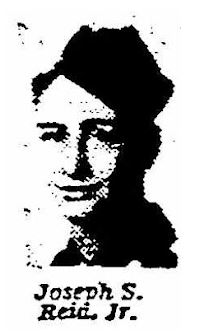
I provided the obituary and photo to Fields of Honor and was asked if I could help with missing photos for Indiana men. I agreed to do what I could and selected Lake and Elkhart counties.
Lake County, Indiana is a particularly tricky place to research as many of Gary’s records have disappeared with the city’s decline. Of course, most of the men I needed photos for had resided in Gary. I again did a preliminary online search as I had for Joseph and came up with nothing. I then went to the Lake County, Indiana obituary database that the public library system has available online. NONE of the names appeared in the database. I know that database contains names of people who have died elsewhere, like my grandmother for example, so why were all of these men missing? Then it hit me – I recalled during the Vietnam War that those killed in action had a special write up in the local paper, the Gary [IN] Post Tribune. Could it be possible that this was also a practice in other wars?
Before emailing the library research team I decided, as a backup, to find more information about the men. I turned to the 1940 US Federal census to try to get an address of where they were residing. Knowing the area, I thought I could turn to school yearbooks to find a photo. I could narrow the search to the nearest zoned high school based on the 1940 address. A few men were not found in the census in Lake County. That’s not surprising as many men moved to Gary after graduating to secure work in one of the steel mills. That newly acquired info just gave me another place to look if the newspaper didn’t have a photo.
I then contacted the research library staff and am happy to report the following Gary men have been found:
Cloyce Neal Blassingame served in the first integrated Army unit:
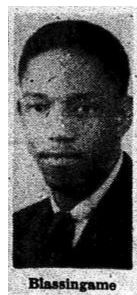
Robert E. Cook:
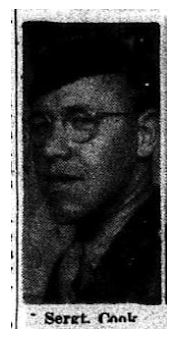
Robert W. Ferguson:
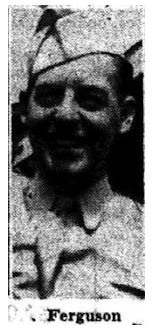
Robert Ferguson was also found in Emerson’s school year book.
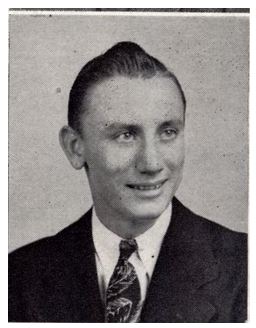
and Gordon Miller in Lew Wallace’s school year book:

(The year book publication date was 1946 and Gordon died in 1944. There was not a 1945 year book, possibly due to the war. Gordon was pictured with the class of 1944 but I’d like to find verification elsewhere like I did with Robert Ferguson.)
I am still in need of finding photos of the following men:
- George Fedorchak Jr. (son of Mrs. Mary Fedorchak, 1428 W 13th Avenue, Gary; in 1940 he lived with his widowed mother, Anna, and sisters Marguerite, Genevieve and Helen at 800 “This South Avenue” probably Harrison Street, Gary. He born about 1920. Perhaps mother’s name was Mary Ann?).
- Edward A. Gooding
- Mike Zigich (son of Pete & Annie, 2077 Grant St., Gary, born about 1926. His only sibling predeceased him as a child. Parents and sibling buried in a Russian Orthodox Cemetery on Ridge Road. I wrote the parish for a possible church directory photo but did not get a response yet.)
The Zigich name is driving me crazy because I seem to remember Zigich’s when I lived in Gary as a kid. I’m thinking Mike’s father was a friend of my grandfather. Their burial place was only a mile from where I lived. (This is off topic but my dear readers know how my brain works – I know I’m not alone in having a hazy memory from my youth so this is another reason TO WRITE EVERYTHING YOU DO REMEMBER DOWN NOW about your own family.)
So, this gets a little creepy – as the pictures were discovered it slowly dawned on me that people I knew would have known these individuals. My mother-in-law would have attended Emerson High School with Robert Ferguson. My aunt and uncle would have attended Lew Wallace with Gordon Miller. I do recall that Lew Wallace had a memorial to the fallen; I even read the names once when I was waiting for a ride home before I had my driver’s license but the names on the memorial were meaningless to me. As a teen in the 1970’s, the 1940’s seemed to be in the olden days. The names listed were just names, not real people to me.
As the world seems to be forgetting the lessons once learned, “lest not forget” these brave individuals who gave everything they had to end tyrrany. Don’t let these lives cut short be forgotten! The Fields of Honor is looking for photos from across the United States. Click on their database and contribute a picture of a family member or someone from your hometown. It only takes a few minutes to check your local newspaper archive or public library. Your help is not only preserving their memory, it’s also supporting society’s fundamental principles in our troubled world.





